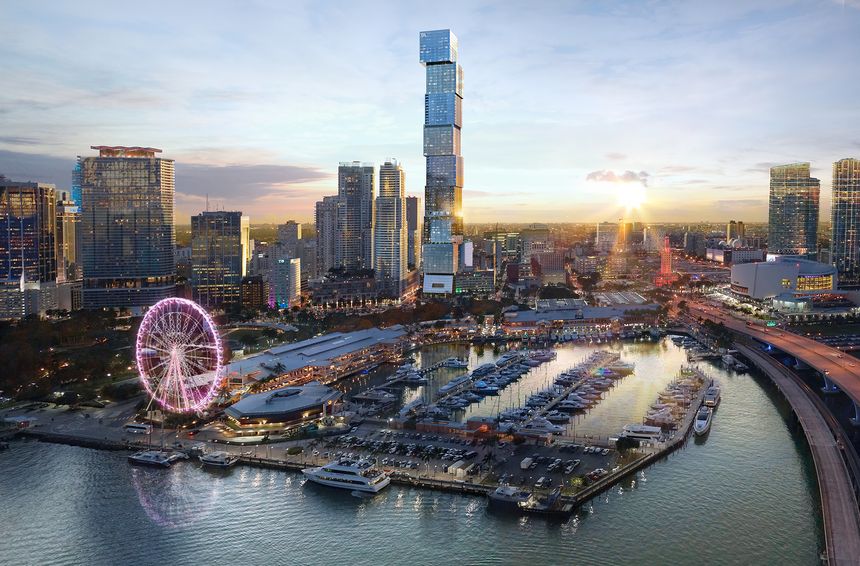As reported by the Wall Street Journal:
Miami’s Waldorf Astoria residential tower, poised to be South Florida’s tallest skyscraper, is a test case for new techniques meant to enable the more than 1,000-foot tall building to withstand hurricane-force winds and remain stable near sea level.
Developers broke ground on the building’s foundation in downtown Miami in October. The 100-story tower, which resembles a series of glass cubes stacked on top of each other, will feature 205 hotel guest rooms and 360 luxury condo residences. It would be the city’s first supertall structure, and the tallest residential building south of New York City when completed around 2027, according to the development team.
Supertall towers, which architects tend to define as buildings that rise at least 300 meters, or 984 feet, have been common in cities such as New York and Chicago. But no one has succeeded in building one in Miami.
A major challenge has been to create a tower that could rise that high on land near sea level, which requires digging deep into the earth, past the porous limestone and water table and into the more stable rock below it. Buildings must not tremble under the force of hurricane gales that are increasingly common in the area. Developers also had to secure permission from Miami International Airport since the supertall building would be in the flight path, which took several years to achieve, they said.
 Photo: ArX Solutions
Photo: ArX SolutionsThe building will feature 205 hotel guest rooms and 360 luxury condo residences.
 Photo: ArX Solutions
Photo: ArX SolutionsThe residential tower will be the tallest residential building south of New York City when completed around 2027.
“Where other buildings might have taken four months of foundation, it’s going to take us a year to get all that structure underground just to support this building,” said Kevin Maloney, PMG’s chief executive.
The Waldorf building is so heavy and so large that the 150-knot or 200-knot hurricane-strength winds would not affect it, said Mr. Maloney. The building’s floor plates are each around 20,000 square feet, compared with a recent supertall tower PMG built on Manhattan’s West 57th street, the Steinway, where floor plates are closer to 5,000 square feet, Mr. Maloney said.
“The building code in Miami is the strictest in the country, and that’s true about 1,000-foot towers or eight-story towers,” said Ryan Shear, Managing Partner of PMG. “There’s not a city I feel safer in than Miami in terms of hurricane code.”
Developers OKO Group and Cain International also utilized the same foundation technology in a nearby 47-story luxury condo development, known as Una Residences. During the deep soil mixing process last year, water shot up into the foundation, creating what looked like a lagoon. The flooding concerned nearby residents and caused construction delays.
A spokesman for OKO Group and Cain International pointed to the recent $17.75 million sale of a trilevel penthouse at the building, and confirmed that construction has now passed the tower’s fifth level.
 Photo: ArX Solutions
Photo: ArX SolutionsAbout 87% of the condo space in the Waldorf Astoria residential tower has been sold.
The technology also caused hiccups at Miami’s Brickell City Centre development years ago.
A spokesman for the developer, Swire Properties, said that while some adjustments had to be made because of the new technique, the team felt the outcome was successful overall.
Mr. Maloney said that when deep soil mixing caused issues, the technology was “very new, and untried.” He said that it has improved since then and that PMG is already using it in another development, the E11even Hotel & Residences, a luxury 64-story condo tower building in Miami.
About 87% of the condo space in the Waldorf tower has been sold, Mr. Maloney said. Condo units that start at $2 million are sold out, while the units in the two cubes at the top of the building are still on the market, with prices starting at $10 million, he said. Buyers put down 30% of their purchase.
Those sales help to finance construction during a difficult time to build, with interest rates rising and Florida insurance costs shooting up in response to the recent proliferation of insurance claims after storms.
“There’s no question the economy is in a dark place and financing is difficult, but you have to understand also that it’s going to take all of 48 to probably 55 months to build this thing,” said Mr. Maloney, at which point he expects a completely different economic situation.
He said insurance has gone up about 300% over 18 months. For a project like the Waldorf, that means he has to put up tens of millions of dollars at the very beginning. Mr. Maloney said his financing and preconstruction condo sales can cover it, but the sharp rise in insurance is making life difficult for other new developments.
“This is the reason most projects won’t get out of the ground in Florida,” he said.


